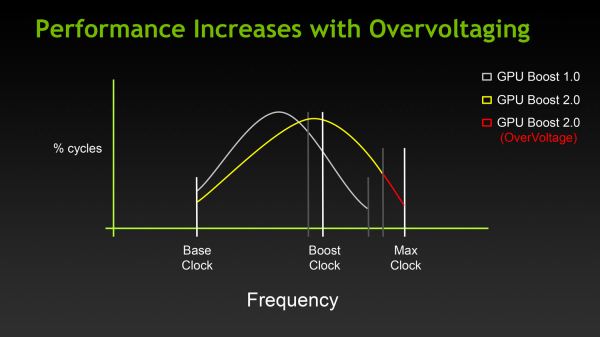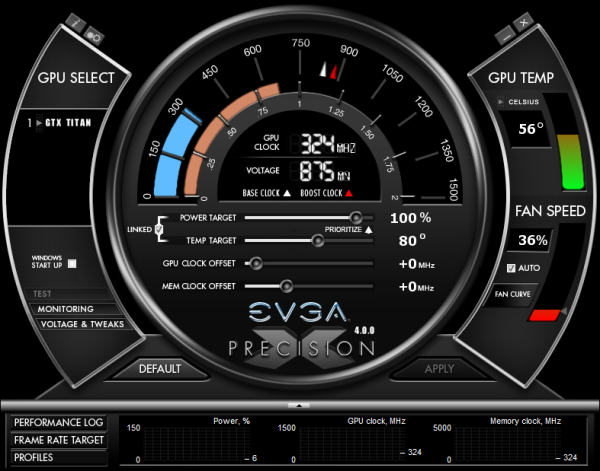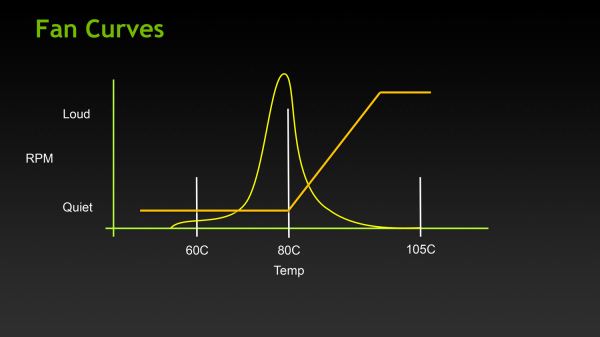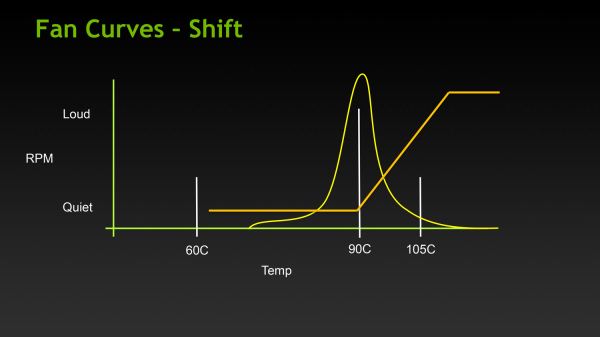NVIDIA's GeForce GTX Titan, Part 1: Titan For Gaming, Titan For Compute
by Ryan Smith on February 19, 2013 9:01 AM ESTGPU Boost 2.0: Overclocking & Overclocking Your Monitor
The first half of the GPU Boost 2 story is of course the fact that with 2.0 NVIDIA is switching from power based controls to temperature based controls. However there is also a second story here, and that is the impact to overclocking.
With the GTX 680, overclocking capabilities were limited, particularly in comparison to the GeForce 500 series. The GTX 680 could have its power target raised (guaranteed “overclocking”), and further overclocking could be achieved by using clock offsets. But perhaps most importantly, voltage control was forbidden, with NVIDIA going so far as to nix EVGA and MSI’s voltage adjustable products after a short time on the market.
There are a number of reasons for this, and hopefully one day soon we’ll be able to get into NVIDIA’s Project Greenlight video card approval process in significant detail so that we can better explain this, but the primary concern was that without strict voltage limits some of the more excessive users may blow out their cards with voltages set too high. And while the responsibility for this ultimately falls to the user, and in some cases the manufacturer of their card (depending on the warranty), it makes NVIDIA look bad regardless. The end result being that voltage control on the GTX 680 (and lower cards) was disabled for everyone, regardless of what a card was capable of.
With Titan this has finally changed, at least to some degree. In short, NVIDIA is bringing back overvoltage control, albeit in a more limited fashion.
For Titan cards, partners will have the final say in whether they wish to allow overvolting or not. If they choose to allow it, they get to set a maximum voltage (Vmax) figure in their VBIOS. The user in turn is allowed to increase their voltage beyond NVIDIA’s default reliability voltage limit (Vrel) up to Vmax. As part of the process however users have to acknowledge that increasing their voltage beyond Vrel puts their card at risk and may reduce the lifetime of the card. Only once that’s acknowledged will users be able to increase their voltages beyond Vrel.

With that in mind, beyond overvolting overclocking has also changed in some subtler ways. Memory and core offsets are still in place, but with the switch from power based monitoring to temperature based monitoring, the power target slider has been augmented with a separate temperature target slider.
The power target slider is still responsible for controlling the TDP as before, but with the ability to prioritize temperatures over power consumption it appears to be somewhat redundant (or at least unnecessary) for more significant overclocking. That leaves us with the temperature slider, which is really a control for two functions.
First and foremost of course is that the temperature slider controls what the target temperature is for Titan. By default for Titan this is 80C, and it may be turned all the way up to 95C. The higher the temperature setting the more frequently Titan can reach its highest boost bins, in essence making this a weaker form of overclocking just like the power target adjustment was on GTX 680.
The second function controlled by the temperature slider is the fan curve, which for all practical purposes follows the temperature slider. With modern video cards ramping up their fan speeds rather quickly once cards get into the 80C range, merely increasing the power target alone wouldn’t be particularly desirable in most cases due to the extra noise it generates, so NVIDIA tied in the fan curve to the temperature slider. By doing so it ensures that fan speeds stay relatively low until they start exceeding the temperature target. This seems a bit counterintuitive at first, but when put in perspective of the goal – higher temperatures without an increase in fan speed – this starts to make sense.
Finally, in what can only be described as a love letter to the boys over at 120hz.net, NVIDIA is also introducing a simplified monitor overclocking option, which can be used to increase the refresh rate sent to a monitor in order to coerce it into operating at that higher refresh rate. Notably, this isn’t anything that couldn’t be done before with some careful manipulation of the GeForce control panel’s custom resolution option, but with the monitor overclocking option exposed in PrecisionX and other utilities, monitor overclocking has been reduced to a simple slider rather than a complex mix of timings and pixel counts.
Though this feature can technically work with any monitor, it’s primarily geared towards monitors such as the various Korean LG-based 2560x1440 monitors that have hit the market in the past year, a number of which have come with electronics capable of operating far in excess of the 60Hz that is standard for those monitors. On the models that have been able to handle it, modders have been able to get some of these 2560x1440 monitors up to and above 120Hz, essentially doubling their native 60Hz refresh rate to 120Hz, greatly improving smoothness to levels similar to a native 120Hz TN panel, but without the resolution and quality drawbacks inherent to those TN products.
![]()
Of course it goes without saying that just like any other form of overclocking, monitor overclocking can be dangerous and risks breaking the monitor. On that note, out of our monitor collection we were able to get our Samsung 305T up to 75Hz, but whether that’s due to the panel or the driving electronics it didn’t seem to have any impact on performance, smoothness, or responsiveness. This is truly a “your mileage may vary” situation.














157 Comments
View All Comments
AeroJoe - Wednesday, February 20, 2013 - link
Very good article - but now I'm confused. If I'm building an Adobe workstation to handle video and graphics, do I want a TITAN for $999 or the Quadro K5000 for $1700? Both are Kepler, but TITAN looks like more bang for the buck. What am I missing?Rayb - Wednesday, February 20, 2013 - link
The extra money you are paying is for the driver support in commercial applications like Adobe CS6 with a Quadro card vs a non certified card.mdrejhon - Wednesday, February 20, 2013 - link
Excellent! Geforce Titan will make it much easier to overclock an HDTV set to 120 Hz( http://www.blurbusters.com/zero-motion-blur/hdtv-r... )
Some HDTV’s such as Vizio e3d420vx can be successfully “overclocked” to a 120 Hz native PC signal from a computer. This was difficult because an EDID override was necessary. However, the Geforce Titan should make this a piece of cake!
Blazorthon - Wednesday, February 20, 2013 - link
Purely as a gaming card, Titan is obviously way to overpriced to be worth considering. However, it's compute performance is intriguing. It can't totally replace a Quadro or Tesla, but there are still many compute workloads that you don't need those extremely expensive extra features such as ECC and Quadro/Tesla drivers to excel in. Many of them may be better suited to a Tahiti card's far better value, but stuff like CUDA workloads may find Titan to be the first card to truly succeed GF100/GF110 based cards as a gaming and compute-oriented card, although like I said, I think that the price could still be at least somewhat lower. I understand it not being around $500 like GF100/110 launched at for various reasons, but come on, at most give us an arpund $700-750 price...just4U - Thursday, February 21, 2013 - link
Some one here have stated that AMD is at fault for pricing their 7x series so high las year. Perhaps many were disapointed with the $550 price range but that's still somewhat lower than previously released Nvidia products thru the years. Several of those cards (at various price points) handily beat the 580 (which btw never did get much of a price drop) and at the time that's what it was competing against.So I can't quite connect the dots in why they are saying that it's AMD's fault for originally pricing the 7x series so high when in reality it was still lower than newly released Nvidia product over the past several years.
CeriseCogburn - Monday, March 4, 2013 - link
For the most part, correct.The 7970 came out at $579 though, not $550. And it was nearly not present for many months, till just the prior day to the 680's $499 launch.
In any case, ALL these cards drop in price over the first six months or so, EXCEPT sometimes, if they are especially fast, like the 580, they hold at the launch price, which it did, until the 7970 was launched - the 580 was $499 till the day the 7970 launched.
So what we have here is the tampon express. The tampon express has not paid attnetion to any but fps/price vs their revised and memory holed history, so it will continue forever.
They have completely ignored capital factors like the extreme lack of production space in the node, ongoing prior to the 7970 release, and at emergency low levels prior to the months later 680 release, with the emergency board meeting, and multi-billion dollar borrowing buildout for die space production expansion, not to mention the huge change in wafer from dies payment which went from per good die to per wafer cost, thus placing the burden of failure on the GPU company side.
It's not like they could have missed that, it was all over the place for months on end, the amd fanboys were bragging amd got diespace early and constantly hammering away at nVidia and calling them stupid for not having reserved space and screaming they would be bankrupt from low yields they had to pay for from the "housefires" dies.
So what we have now is well trained (not potty trained) crybabies pooping their diapers over and over again, and let's face it, they do believe they have the power to lower the prices if they just whine loudly enough.
AMD has been losing billions, and nVidia profit ratio is 10% - but the crying babies screams mean to assist their own pocketbooks at any expense, including the demise of AMD even though they all preach competition and personal CEO capitalist understanding after they spew out 6th grader information or even make MASSIVE market lies and mistakes with illiterate interpretation of standard articles or completely blissful denial of things like diespace (mentioned above) or long standing standard industry tapeout times for producing the GPU's in question.
They want to be "critical reporters" but they fail miserably at it, and merely show crybaby ignorance with therefore false outrage. At least they consider themselves " the good hipster !"
clickonflick - Thursday, March 7, 2013 - link
i agree that the price of this GPU is really high , one could easily assemble a fully mainstream laptop online with dell at this price tag or a desktop, but for gamers, to whom performance is above price. then it is a boon for themfor more pics check this out
clickonflick/nvidia-geforce-gtx-titan